
The Autonomous Navigation System (ANS) was a 2007-2011 combat vehicle upgrade used to convert manned vehicles to autonomous unmanned capability or to upgrade already unmanned vehicles to be autonomous. [1]

The Autonomous Navigation System (ANS) was a 2007-2011 combat vehicle upgrade used to convert manned vehicles to autonomous unmanned capability or to upgrade already unmanned vehicles to be autonomous. [1]
ANS was an on board, integrated suite of sensors and technology that enabled autonomous navigation, perception, path-planning and vehicle-following capabilities for unmanned ground vehicles, allowing them to move on the battlefield with minimal human oversight. Some tasks the system already performed in tests included move-on-route, obstacle detection and avoidance and leader/follower capabilities in both day and night conditions. Originally designed by the Army for integration on the Armed Robotic Vehicle-Assault (Light) (ARV-A(L)), the ANS has also been tested on vehicles including Strykers, MULE Engineering Evaluation Units, and Light Medium Tactical Vehicles (LMTV). [2]
The Critical Design Review found the ANS to be at a maturity level consistent with moving to the prototype fabrication phase and that its assessments and critical issues presented low risk with 95 percent of its requirements met. Closure of the CDR was expected in late August 2010. Prototype delivery was scheduled for late 2011 and Integrated Qualification Testing would begin in 2012. The Army ended development work on the system and ARV in July 2011 stating that the system "did not warrant continued investment,". [3]
{{cite journal}}: Cite journal requires |journal= (help){{cite journal}}: Cite journal requires |journal= (help)This article incorporates work from , which is in the public domain as it is a work of the United States Military.
An autonomous robot is a robot that acts without recourse to human control. The first autonomous robots environment were known as Elmer and Elsie, which were constructed in the late 1940s by W. Grey Walter. They were the first robots in history that were programmed to "think" the way biological brains do and meant to have free will. Elmer and Elsie were often labeled as tortoises because of how they were shaped and the manner in which they moved. They were capable of phototaxis which is the movement that occurs in response to light stimulus.

The Boeing X-45 unmanned combat air vehicle is a concept demonstrator for a next generation of completely autonomous military aircraft, developed by Boeing's Phantom Works. Manufactured by Boeing Integrated Defense Systems, the X-45 was a part of DARPA's J-UCAS project.

Future Combat Systems (FCS) was the United States Army's principal modernization program from 2003 to early 2009. Formally launched in 2003, FCS was envisioned to create new brigades equipped with new manned and unmanned vehicles linked by an unprecedented fast and flexible battlefield network. The U.S. Army claimed it was their "most ambitious and far-reaching modernization" program since World War II. Between 1995 and 2009, $32 billion was expended on programs such as this, "with little to show for it"..
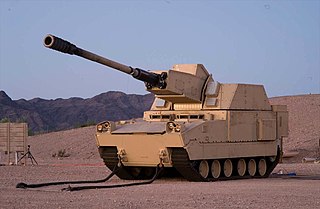
The XM1203 Non-Line-of-Sight Cannon (NLOS-C) was a 155 mm self-propelled howitzer. It was the lead vehicle for the U.S. Army's Future Combat Systems Manned Ground Vehicles program.

An unmanned ground vehicle (UGV) is a vehicle that operates while in contact with the ground and without an onboard human presence. UGVs can be used for many applications where it may be inconvenient, dangerous, or impossible to have a human operator present. Generally, the vehicle will have a set of sensors to observe the environment, and will either autonomously make decisions about its behavior or pass the information to a human operator at a different location who will control the vehicle through teleoperation.
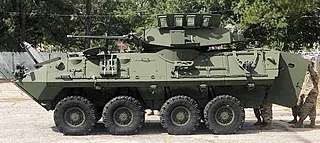
The LAV-25 is a member of the LAV II family. It is an eight-wheeled amphibious armored reconnaissance vehicle built by General Dynamics Land Systems and used by the United States Marine Corps and the United States Army.

The Multi-Mission Unmanned Ground Vehicle, previously known as the Multifunction Utility/Logistics and Equipment vehicle (MULE), was an autonomous unmanned ground combat vehicle developed by Lockheed Martin Missiles and Fire Control for the United States Army's Future Combat Systems and BCT Modernization programs. The last component of the program was canceled in July 2011.
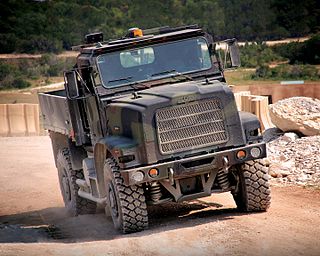
TerraMax is the trademark for autonomous/unmanned ground vehicle technology developed by Oshkosh Defense. Primary military uses for the technology are seen as reconnaissance missions and freight transport in high-risk areas so freeing soldiers from possible attacks, ambushes or the threat of mines and IEDs. The technology could also be used in civilian settings, such as autonomous snow clearing at airports.
A program executive officer, or PEO, is one of a few key individuals in the United States military acquisition process. As can be seen from the examples below, a program executive officer may be responsible for a specific program, or for an entire portfolio of similar programs.
The United States Army DEVCOM Ground Vehicle Systems Center (GVSC) (formerly United States Army Tank Automotive Research, Development and Engineering Center (TARDEC)), located in Warren, Michigan, is the United States Armed Forces' research and development facility for advanced technology in ground systems. It is part of the U.S. Army Combat Capabilities Development Command (DEVCOM), a major subordinate command of the U.S. Army Futures Command. GVSC shares its facilities with the United States Army Tank-automotive and Armaments Command (TACOM). Current technology focus areas include Ground Vehicle Power and Mobility (GVPM), Ground System Survivability and Force Protection, among others.
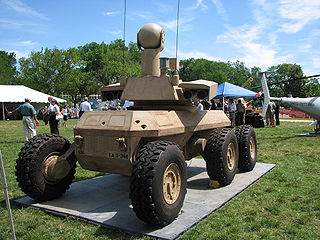
The XM1219 Armed Robotic Vehicle was an unmanned ground combat vehicle based on the MULE Platform. The ARV-A-L MULE Vehicle (XM1219) would feature integrated anti-tank and anti-personnel and reconnaissance, surveillance, and target acquisition (RSTA) systems remotely operated by network linked soldiers. The Armed robotic vehicle was canceled in July 2011 over mobility concerns.

The Legged Squad Support System (LS3) was a DARPA project for a legged robot which could function autonomously as a packhorse for a squad of soldiers or marines. Like BigDog, its quadruped predecessor, the LS3 was ruggedized for military use, with the ability to operate in hot, cold, wet, and dirty environments. The LS3 was put into storage in late 2015.

The Manned Ground Vehicles (MGV) was a family of lighter and more transportable ground vehicles developed by BAE Systems and General Dynamics as part of the U.S. Army's Future Combat Systems (FCS) program. The MGV program was intended as a successor to the Stryker of the Interim Armored Vehicle program.

The Ground Combat Vehicle (GCV) was a program initiated by the United States Army in 2009, with the goal of developing a next-generation armored fighting vehicle. The first variant of the GCV to be developed would be an infantry fighting vehicle to replace the M2 Bradley.

The Ripsaw is a series of developmental unmanned ground combat vehicles designed by Howe & Howe Technologies for evaluation by the United States Army.
FCS/BCT unmanned aerial vehicles was a collection of unmanned aerial vehicles developed under the jurisdiction of the Future Combat Systems (FCS) program until it was dissolved and succeeded by the BCT Modernization program.
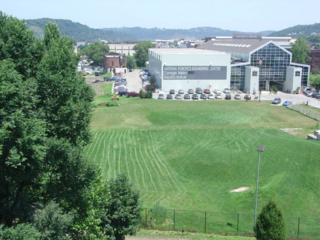
The National Robotics Engineering Center (NREC) is an operating unit within the Robotics Institute (RI) of Carnegie Mellon University. NREC works closely with government and industry clients to apply robotic technologies to real-world processes and products, including unmanned vehicle and platform design, autonomy, sensing and image processing, machine learning, manipulation, and human–robot interaction.

The Tactical Robotics Cormorant, formerly AirMule or Mule, Israel Defense Forces (IDF) codename Pereira, is a flying car unmanned aerial vehicle (UAV) built by Tactical Robotics Ltd., a subsidiary of designer Rafi Yoeli's Urban Aeronautics Ltd., in Yavne, Israel. It will be used in search and rescue operations where it is too dangerous or inaccessible for a helicopter, such as evacuating people from the upper stories of burning buildings, or delivering and extracting police and soldiers while very close to structures, narrow streets, or through holes into confined spaces.

The Tactical Airborne Platform for Aerial Surveillance-Beyond Horizon-201 or TAPAS BH-201 is a medium-altitude long-endurance (MALE) unmanned aerial vehicle (UAV) being developed in India by Aeronautical Development Establishment (ADE) on the lines of General Atomics MQ-1 Predator.

The United States Army Futures Command (AFC) is a United States Army command that runs modernization projects. It is headquartered in Austin, Texas.